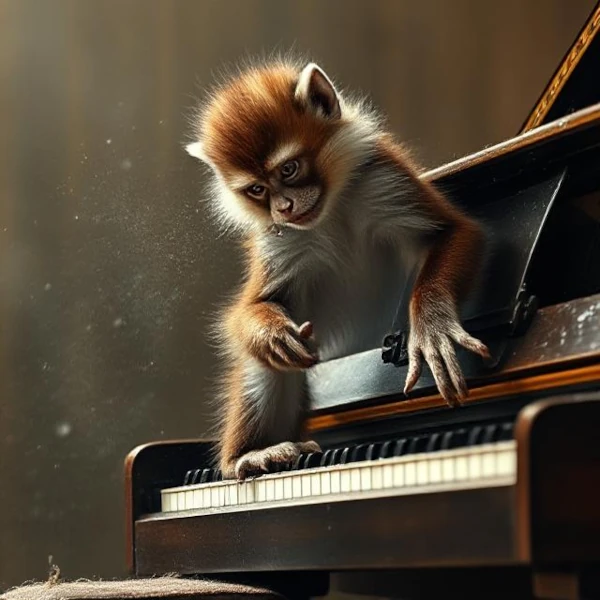
An immortal monkey, randomly hitting a piano twice per second and also randomly choosing the duration of each note, would on average take: ≈ 1.6 × 109834 years to randomly play Beethoven's entire 5th Symphony. So, even for an immortal monkey in an infinite multiverse, it is practically impossible.
It seems even more improbable to go from a bacterium to a human than for an immortal monkey to play Beethoven. Yet, it happened.
Evolution is a directed process (by natural selection), cumulative, and benefits from astronomical time and resources. Unlike the pianist monkey, life does not "start from scratch" each generation. What seems miraculous is only the result of billions of years of trials, errors, and successful adaptations in a conducive environment.
This is the difference between a purely random probability (the monkey) and a probability channeled by physical and biological rules (evolution).
| Event | Degree of improbability | System | Context |
|---|---|---|---|
| A monkey plays Beethoven | ≈ 1.6 × 109834 | Pure randomness | Without feedback, without selection |
| A bacterium evolves into Homo sapiens | Extremely improbable as well | But subject to evolution, selection, backtracking or abandonment of a solution ("backtracking") | With memory, reproduction, competition, adaptation |
It is tempting to imagine evolution as a cosmic game of dice, a pure product of chance. After all, the genetic mutations that introduce variability into populations are random. But evolution is not a simple stochastic drift: it relies on a fundamental non-random principle, natural selection. This mechanism, formulated by Charles Darwin (1809-1882), acts as a filter, guiding evolution by preserving the variants best adapted to the environment.
Unlike the monkey that types completely at random, biological evolution is a non-random process guided by natural selection: advantageous mutations are preserved, others are eliminated.
The common mistake is to confuse mutation (random) with evolution (guided process). A useful analogy is that of the immortal monkey typing on a piano: although it could, statistically, play Beethoven's Fifth Symphony by chance, the probability of it achieving this in less than \(10^{9834}\) years is infinitesimal. Evolution, on the other hand, accumulates successes generation after generation. It does not try all combinations at random; it learns.
Evolution does not start from scratch at each step. Each innovation (DNA, eukaryotic cells, multicellularity, etc.) serves as the basis for the next step. It is a cumulative process, unlike the piano where each note is independent.
If the monkey had to first reproduce a measure, then two, then a musical phrase (with memorization of successes), the probability would increase radically. The monkey does not have a piano that rewards good notes.
Natural selection acts like an optimization algorithm: it retains the genetic variations that increase survival and reproduction. Even neutral or slightly disadvantageous mutations can persist or disappear depending on the environmental context. This constant interaction between variation and selection gives rise to evolutionary trajectories that, although undirected, are not arbitrary.
In other words, the complexity of life does not result from a statistical miracle. It emerges from an iterative process combining genetic noise and adaptive sorting. Extraordinarily complex biological structures, such as the eye or the brain, did not arise all at once by chance, but were slowly refined, layer by layer, like in an evolutionary algorithm.
Comparing evolution to a perpetual lottery is to ignore the determining role of environmental feedback. The latter, by selecting what works, introduces a form of emergent order into an apparently chaotic system. This is precisely what distinguishes a monkey playing at random from a biological system evolving towards complexity.
| Characteristic | Evolution by natural selection | Pure random process |
|---|---|---|
| Source of variation | Genetic mutations (random) | Random fluctuations without defined mechanism |
| Feedback | Yes (natural selection) | None |
| Accumulation of successes | Yes, via differential reproduction | No, no memory of past events |
| Direction | Guided by the environment (without final goal) | No direction, pure wandering |
| Time for a complex system to appear | Millions to billions of years, but realistic | Exponentially astronomical time |
| Emergent structure | Functional, adapted (e.g., eye, wing, brain) | Rare, incoherent, even chaotic |
| Analogical example | Evolutionary algorithm with sorting and mutation | Immortal monkey playing randomly on a piano |
Sources: Darwin (1859), Maynard Smith (1986), Dawkins (1986), Gould (1990), Nowak (2006), Lehninger (2021)
What seems miraculous is only the result of billions of years of trials, errors, and successful adaptations in a conducive environment. This is the difference between a purely random probability (the monkey) and a probability channeled by physical and biological rules (evolution by natural selection).